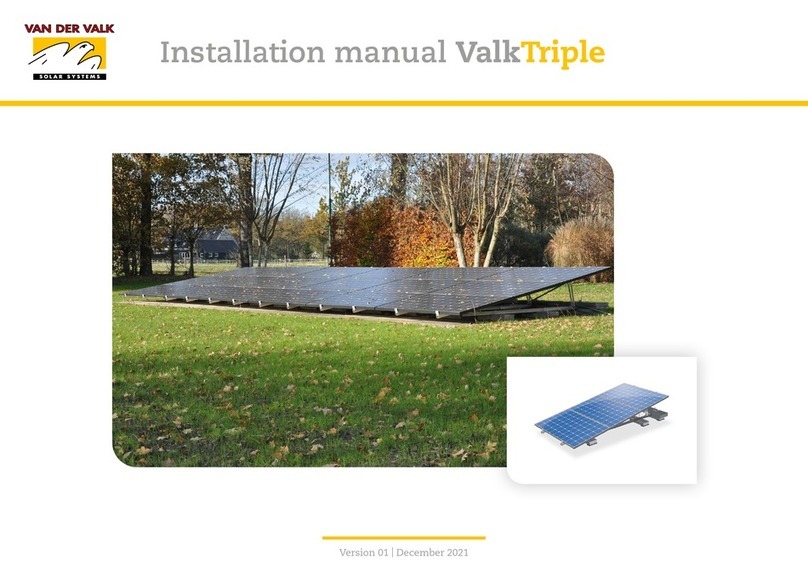
PAGE 5 OF 18
MISSION SOLAR ENERGY LLC
ELECTRONIC versions are uncontrolled except when accessed directly from document control directory. Printed copies are uncontrolled unless verified against online document.
COPYRIGHT 2019 MISSION SOLAR ENERGY LLC, ALL RIGHTS RESERVED
5.0 SAFETY
5.1 GENERAL WARNING
You must understand and follow all applicable local, state
and federal regulations in addition to standards for
building construction, electrical design, fire and safety.
Check with local authorities to determine applicable
permitting requirements before attempting to install or
maintain PV modules.
•Module interconnects pass direct current (DC) when
exposed to sunlight or other light sources.
•Contact with electrically active parts of the module,
such as terminals, can result in injury or death,
whether the module is connected or disconnected.
•Never wear metallic rings, watch bands, ear, nose or
lip rings or other metallic devices when installing or
trouble shooting a photovoltaic system.
5.2 MECHANICAL
•Rooftop PV systems should only be installed on
dwellings that have been formally analyzed for
structural integrity, and confirmed to be capable of
handling the additional weighted load of PV system
components including PV modules by a certified
building specialist or engineer. For your safety, do not
attempt to work on a rooftop until safety precautions
have been identified and taken, including without
limitation fall protection measures, ladders or
stairways, and personal protective equipment (PPE).
•For your safety, do not install or handle PV modules
under adverse conditions, including and without
limitation - strong or gusty winds and wet or frosted
roof surfaces.
•The flat-plate PV module construction consists of a
laminated assembly of solar cells encapsulated within
an insulating material with a rigid glass surface and an
insulated substrate. The laminated assembly is
supported by an aluminum frame that is also used for
mounting the module.
5.3 ELECTRICAL SHOCK HAZARD
•PV modules can produce current and voltage when
exposed to light of any intensity. Electrical current
increases with higher light intensity.
•DC voltage of 30 Volts or higher is potentially lethal.
Contacting the live circuitry of a PV system operating
under light can result in lethal electric shock.
•Use insulated tools and do not wear metallic jewelry
while working with PV modules.
In order to avoid arcing and electrical shock, do not
disconnect electrical connections under load.
•Faulty connections can also result in arcing and
electrical shock.
•Keep connectors dry and clean; ensure that they are in
proper working condition.
•Never insert metallic objects into the connectors, or
modify them in any way in order to secure an electrical
connection.
•Do not touch or handle PV modules with broken glass,
separated frames or a damaged back sheet unless the PV
modules are first disconnected and you are wearing
proper PPE.
•Avoid handling PV modules when they are wet unless
cleaning the PV modules as directed in this manual. See
12.2 Cleaning.
•Never touch electrical connections that are wet without
protecting yourself with insulated gloves. Artificially
concentrated light should not be directed on the module
or panel.
5.4 FIRE
•Mission Solar Energy modules have a Type 1, Class C fire
resistance rating in accordance with the IEC 61730 and UL
1703 standard.
•The fire rating of this module is valid only when mounted
in the manner specified in the mechanical mounting
instructions. See 9.0 Mechanical Installation
•PV modules are electricity generating devices that may
affect the fire safety of a building.
•The use of improper installation methods and/or defective
parts may result in the unexpected occurrence of an
electrical arc during operation.
•The recommended standoff height is no less than 150mm
(6 inches). If other mounting means are employed this
may affect the fire class ratings. A minimum slope of 5in/ft.
for installation over a roof is required to maintain the class
C fire rating. Modules must be mounted over a fire
resistant roof covering rated for the application.
•In order to mitigate the risk of fire in this event, PV
modules should not be installed near flammable liquids,
gases and/or locations with hazardous materials.
•In the event of a fire, PV modules may continue to produce
a dangerous voltage, even if they have been disconnected
from the inverter, have been partly or entirely destroyed,
or the system wiring has been compromised or destroyed.
•In the event of fire, inform the fire crew about the
particular hazards from the PV system, and stay away from
all elements of the PV system during and after a fire until
the necessary steps have been taken to make the PV
system safe.
WARNING





























